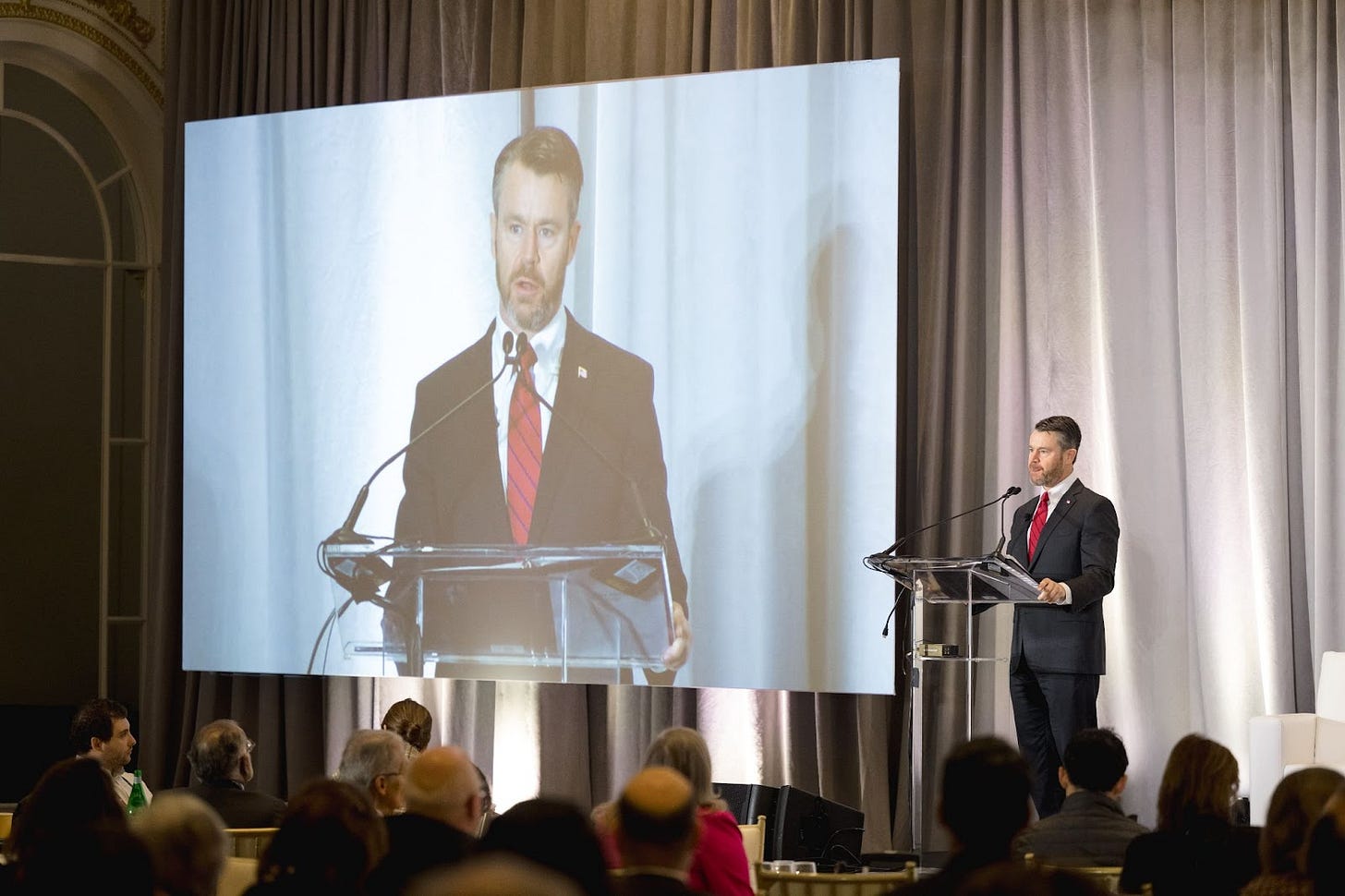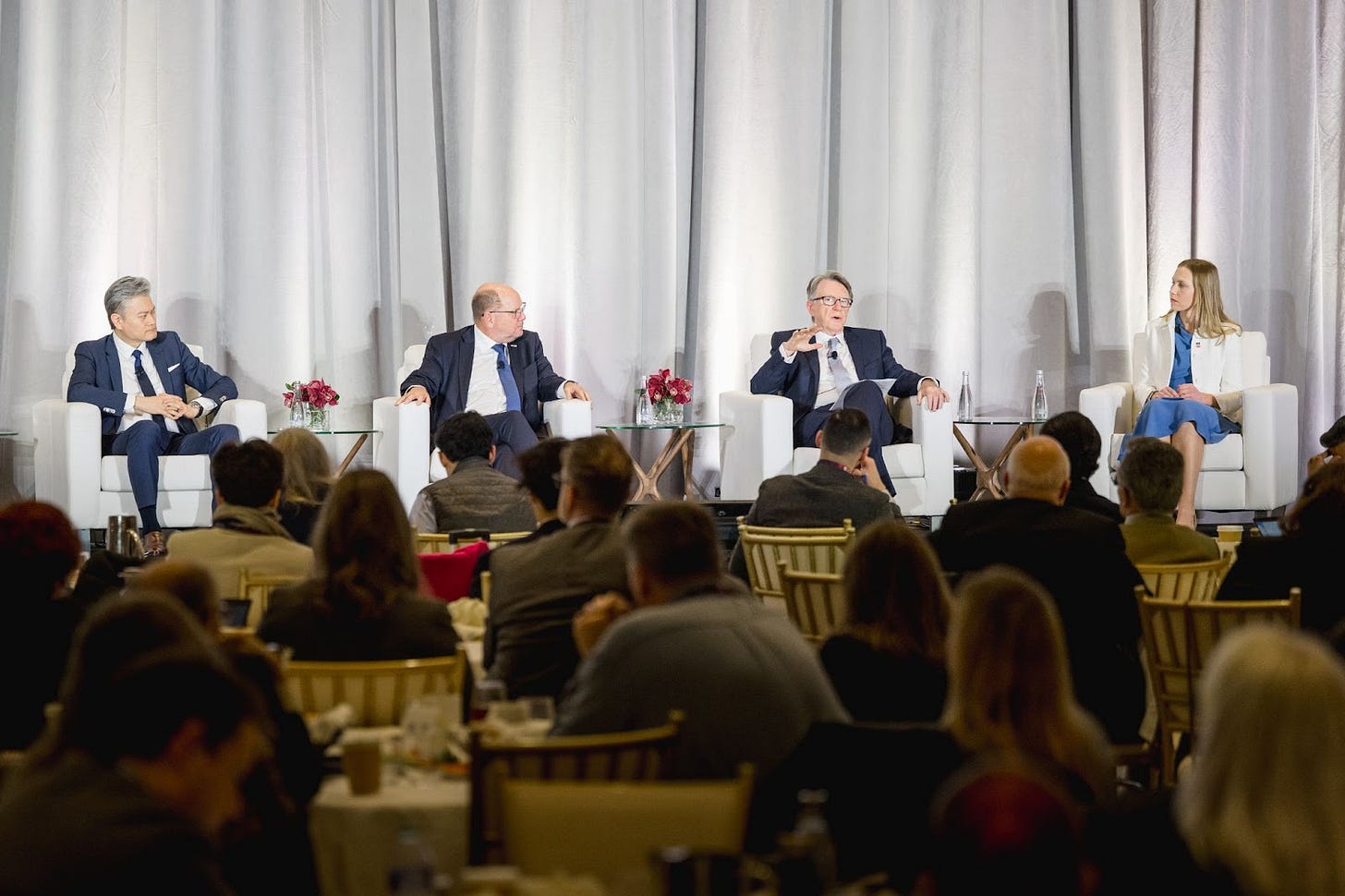How AI & Biotechnology Will Shape American Technological Progress
Recapping the SCSP & NSCEB AI+ Biotechnology Summit
Hello, I'm Ylli Bajraktari, CEO of the Special Competitive Studies Project. In this edition of SCSP's newsletter, we distill key takeaways from our AI+ Biotechnology Summit held on April 10, 2025—the final event in our AI+ Summit Series. Held in partnership with the National Security Commission on Emerging Biotechnology, this Summit was special, as it marked the release of the Commission’s final report, providing strategic recommendations to guide present and future national biotechnology efforts. We are grateful to everyone who participated in this critical conversation about America's biotechnology future.
Don’t miss what’s happening next. Join leaders shaping the future of innovation at the SCSP AI+ Expo, June 2–4. Register today!
How AI & Biotechnology Will Shape American Technological Progress

The next step change in technology is unfolding before our eyes. Biotechnology is converging with artificial intelligence, advanced computing, and modern manufacturing at breathtaking speed. The result will be a new, general-purpose set of tools for building with biology—changing how we make everything from novel vaccines and agricultural tools to game-changing battlefield armor and medicines.
Nations will jockey to win this next era of tech power. Yet, ambition alone won’t guarantee America’s lead. China, among others, is powering ahead with massive state investments in strategic biotech fields—a reminder that the United States must respond with urgency, creativity, and strategic heft.
The AI+ Biotechnology Summit brought together leaders from government, industry, startups, and academia to tackle a fundamental question: What actions must the United States take now and in the future to secure global leadership in biotechnology?
Why AI-Driven Biotechnology Matters

For decades, biotechnology promised cures for diseases, improved crop yields, and new materials. Now, AI is collapsing research timelines from years to months, translating rich biological data into real-world innovation. The strategic application of AI with biotechnology for defense and government missions cannot be overstated. Within reach is a future of American innovation that includes bioengineered gel for wound care and transparent armor for the battlefield, 3D-printed biomaterials, and even the de-extinction of species like the dire wolf through advanced biotechnologies.
Like AI, biotechnology will be a general purpose technology that underpins critical areas like energy independence, defense applications, supply chains, and American agricultural resilience. The summit conversations expressed strong optimism for an era of new bioindustrial policies but also deep caution: if the United States does not bolster R&D, modernize regulatory structures, and create investment incentives for biomanufacturing scale-up, it risks ceding biotech’s trillion-dollar potential—and the strategic leverage it offers—to our competitors.
Biotech Competition Requires Strategic Action

As the Commission makes clear in its report, “China is quickly ascending to biotechnology dominance.” Through massive state-directed funding, industrial coordination, access to vast genomic datasets, and control over critical pharmaceutical components, China is emerging as a key biotech competitor. Chinese investors are not only acquiring U.S. biotech intellectual property, but filling gaps in our ecosystem by offering U.S. innovators access to new, state-of-the-art facilities in China. This is a strategic campaign to fill global biomanufacturing voids and pull value chains toward Beijing’s growing technology spheres of influence. Without a deliberate U.S. response, we risk a future where innovations developed in America are manufactured, regulated, and scaled elsewhere. To compete, the United States must act with urgency: scaling biomanufacturing infrastructure, accelerating public-private partnerships, deploying smart trade tools, and strengthening biotech research security.
To mount an effective response, the United States must also join forces with allies and like-minded partners. America’s allies and partners contribute complementary strengths, from the United Kingdom’s and Sweden’s vast health data infrastructure to South Korea’s biomanufacturing scale. Together, we can drive innovation, align biotech standards, co-develop and protect supply chains, and ensure democratic values guide the future of this technology.

Scaling Biomanufacturing Capacity to Produce Everything

One of the thorniest challenges for U.S. biotech leadership will be scale. Like in other “deep tech” areas, while the United States possesses formidable research centers and venture capital, there are gaping “valleys of death” when it comes time to shift from the lab to large-scale production. Shortages of pilot and demonstration facilities risk hindering the commercialization of new molecules and bio-based materials. Nevertheless, the U.S. holds a strategic advantage in its geography. America possesses abundant, renewable feedstocks, including millions of acres of corn and other bioindustrial inputs. If better integrated into biomanufacturing pipelines, these natural assets could one day enable U.S. biomanufacturing giants to dominate global materials production.
Looking across the value chain – from inputs to outputs – biotechnology offers a unique set of factors that could enable distributed, localized production. The U.S. can apply lessons from national initiatives like the CHIPS & Science Act to bolster U.S. biotech leadership through targeted investments, cost-shared pilot plants that catalyze a thriving industry, and streamlining approvals for new bio-based ventures.
Yet the heart of American Biomanufacturing will be built from the ground up. From the mountains of the northeast in New Hampshire, to the American heartland in states like Indiana, local efforts, spurred by private and federal investment, are already transforming key manufacturing hubs, revitalizing communities with new jobs, and anchoring biomanufacturing at home.
Building a Robust Innovation Ecosystem for Biotech

To meet the moment, America needs to invest in the building blocks of the future biotech innovation ecosystem: the workforce, infrastructure, and regulatory clarity. Demand for a bio-ready workforce is growing fast. Building that workforce starts with education: improving “bioliteracy” so students and workers alike gain a solid grounding in biology and biotech. Introducing biology fundamentals earlier—especially in high school—helps future professionals link scientific knowledge to real-world applications. In regions like Appalachia, school districts are already taking the lead, incorporating synthetic biology into curricula and training students on biomanufacturing processes before they even enter the job market.
Upgrading physical infrastructure is equally important: the United States needs modern, multipurpose biomanufacturing facilities that adapt to different products and processes. Such factories, like modern data centers that can adapt to new AI models, chip designs, and energy sources, would enable the rapid scaling of new innovations. This kind of adaptable infrastructure is essential so early-stage biotech innovators aren’t limited by rigid, single-purpose facilities—especially during moments of national need, as seen with the surge in demand for producing COVID-19 tests and vaccines.
The United States must also modernize and clarify a pro-innovation regulatory framework for biotechnology. Inconsistent policies across sectors—such as biopharma, agriculture, and consumer health—create disparities in incentives and slow the path from lab to market. While maintaining federal agency standards and rigor, reforms must bring clarity, speed, and interagency coordination to keep pace with scientific advances. This will ensure biotech players have access to innovation, and prevent the United States from falling behind countries like China, where regulatory policies allow biotech products to reach the market faster and at lower cost.
Advancing Boldly for the American BioCentury

One consistent message echoed throughout the Summit: “Biotechnology leadership is America’s to lose.” Competition is at a tipping point: U.S. biotech innovation is being slowed not by capability, but by our capacity to translate invention into true innovation power. A bold strategy is needed to position the United States as biotech’s global powerhouse. The time is now to leverage AI to accelerate biotech R&D and build the infrastructure for a thriving domestic ecosystem. The alternative is to let faster-moving rivals dominate. The stakes are America’s role in the future bioeconomy and our national security.
The NSCEB’s report crystallizes this moment and offers a vision for how America can chart a course through it. Whether we seize this opportunity depends on how decisively leaders across government, industry, and academia turn NSCEB’s findings into action.
Missed the AI+ Biotechnology Summit or interested in rewatching our sessions? Enjoy the entire event on SCSP’s YouTube Channel.
SCSP has taken over the DMV on WMATA buses and Metro cars! If you see an AI+ Expo ad, take a photo and post it on social media and tag SCSP and use #SCSPSpotted. Those who do will receive a giveaway at the event!



If the U.S. fumbles biotech, it won’t be because we lack talent, it’ll be because we let our systems move too slow and our competitors move too fast.
The bottleneck isn’t discovery. It’s deployment. We’ve got the labs, the ideas, the venture dollars, but not enough flexible factories, clear rules, or scale-ready workforces to bring breakthroughs to market before China does.
It’s a rerun of the semiconductor story: invent the tech here, manufacture it there, then watch the leverage shift. We need to break that loop now. Bio isn’t just about medicine or ag—it’s industrial, strategic, and sovereign. If we don’t build the backbone, someone else will.